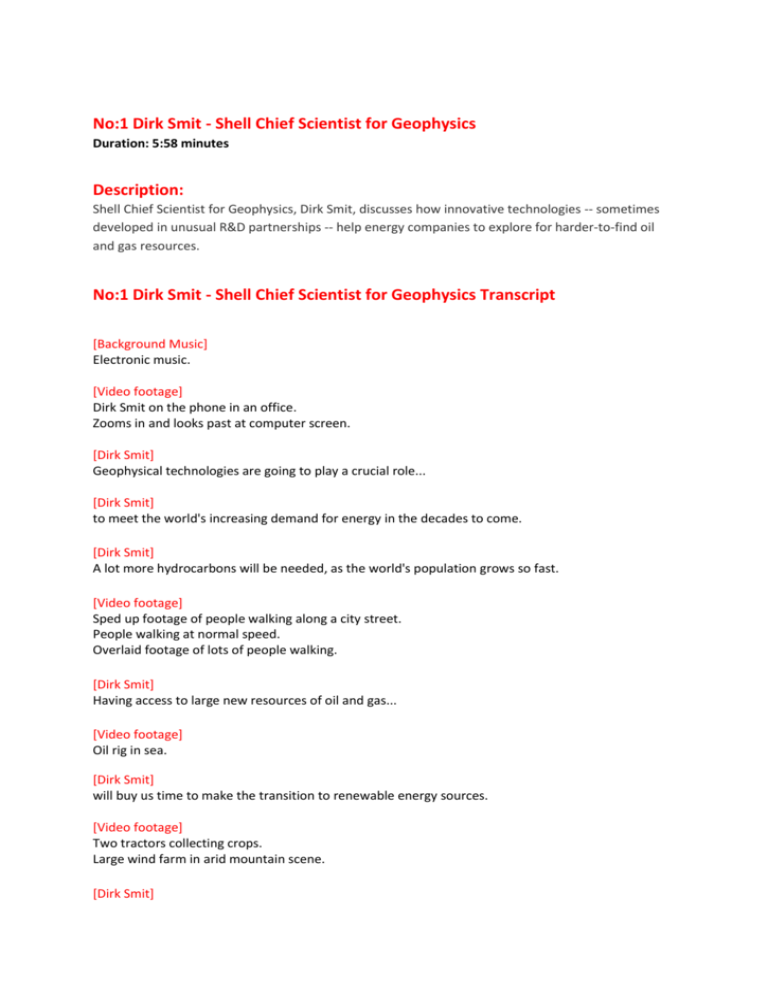Dirk Smit
advertisement

No:1 Dirk Smit - Shell Chief Scientist for Geophysics Duration: 5:58 minutes Description: Shell Chief Scientist for Geophysics, Dirk Smit, discusses how innovative technologies -- sometimes developed in unusual R&D partnerships -- help energy companies to explore for harder-to-find oil and gas resources. No:1 Dirk Smit - Shell Chief Scientist for Geophysics Transcript [Background Music] Electronic music. [Video footage] Dirk Smit on the phone in an office. Zooms in and looks past at computer screen. [Dirk Smit] Geophysical technologies are going to play a crucial role... [Dirk Smit] to meet the world's increasing demand for energy in the decades to come. [Dirk Smit] A lot more hydrocarbons will be needed, as the world's population grows so fast. [Video footage] Sped up footage of people walking along a city street. People walking at normal speed. Overlaid footage of lots of people walking. [Dirk Smit] Having access to large new resources of oil and gas... [Video footage] Oil rig in sea. [Dirk Smit] will buy us time to make the transition to renewable energy sources. [Video footage] Two tractors collecting crops. Large wind farm in arid mountain scene. [Dirk Smit] The challenge we geophysicists are faced with... [Dirk Smit] is that in the pursuit of these large, new resources... [Video footage] Panning over mountains. [Dirk Smit] we are looking for more and more difficult to find hydrocarbons. [Graphic] Footage turns to a computer graphic of mountains. [Dirk Smit] These might be buried several kilometres in the ground... [Dirk Smit] hidden under complex geological formations such as salt... [Graphic] Panning around same graphic of mountain. [Dirk Smit] located under ice shields in the Arctic... [Video footage] Rig in the middle of ice, looks like the Arctic. [Dirk Smit] or just captured in small accumulations that are simply difficult to detect. [Dirk Smit] Of all the international oil companies... [Video footage] Man standing in front of large screen with coloured graphic of mountain. [Dirk Smit] Shell probably has the strongest overall reputation in geophysics. [Video footage] Dirk Smit explaining the computer graphic to the man. [Dirk Smit] We are definitely in the forefront of using... [Dirk Smit] one of the main tools of geophysics, namely; seismic imaging. [Video footage] Zooms in on man listening to Dirk. [Dirk Smit] Seismic imaging plays an essential role in finding oil and gas deposits. [Graphic] Graphic of layers beneath the earth’s surface. Three lorries arrive on the surface. [Dirk Smit] We measure sound waves, bouncing off potentially hydrocarbon bearing rocks... [Graphic] Image made to look like sonar being sent down from lorries into ground. [Dirk Smit] which we then use to compute an image of these layers below the ground... [Graphic] Sound waves bounce back off the different layers below the ground. [Dirk Smit] or under the sea bottom. [Dirk Smit] Salt layers form a shield that interferes with seismic waves... [Graphic] Diagram of sea bed with a salt layer running across it, above a reservoir in the sea bed. Waves being sent from boats aimed at the reservoir. Signals being distorted by the salt layer. [Dirk Smit] so that we cannot see the underlying formations. [Dirk Smit] A promising novel seismic technique today... [Video footage] Dirk standing in front of a large diagram on screen. [Dirk Smit] enables us to illuminate below these seismic shields. [Dirk Smit] Unfortunately, the technique is not cheap... [Dirk Smit] as it involves placing hundreds of sensors on the sea floor. [Video footage] Graphic of rig in sea with two boats. Small yellow squares laid out in grid formation on sea bed. [Dirk Smit] Therefore we are currently only using it on a small scale. [Dirk Smit] But already it dramatically increased the probability of finding hydrocarbons... [Video footage] Coloured computer graphic of what looks like underground layers again. Large block of green in the middle. [Dirk Smit] for example in the Gulf of Mexico, where this picture is taken... [Dirk Smit] sometimes leading to billions of dollars of value... [Graphic] Another graphic of below the earth’s surface. Rotating. [Dirk Smit] from the hundreds of millions of barrels of oil we've discovered. [Dirk Smit] To deploy this measurement technique on a larger scale, costs must be reduced. [Graphic] Zooming in on one portion of the diagram. [Dirk Smit] While its quality and robustness may need to be further improved. [Graphic] Further exploring of the diagram. [Dirk Smit] This would allow us to make more precise measurements more often. [Dirk Smit] This seems an almost impossible task... [Dirk Smit] and it poses a significant challenge to the R&D community. [Dirk Smit] In Shell we are convinced that by working with partners... [Dirk Smit] sometimes outside our industry... [Video footage] Close-up of Dirk Smit writing. [Dirk Smit] we can develop innovative concepts that meet this challenge. [Video footage] Camera pans up to Dirk Smit on the phone. [Dirk Smit] Such unusual R&D alliances have proven to be rich sources of innovation for us. [Dirk Smit] One example is our collaboration with Hewlett-Packard. [Dirk Smit] In this project we are developing a wireless sensing network... [Graphic] Simplified green landscape with five sensors spaced apart. Rows of yellow squares placed on the field in a grid around the sensors. A pylon type sensor lands in the middle. [Dirk Smit] that could revolutionise the way we gather seismic data. [Dirk Smit] Some day this technology may allow us to cost effectively collect... [Graphic] Rows of lorries line up alongside the field of sensors. Camera pans out to show beneath the earth’s surface. Shows pipes going down to layers underneath. [Dirk Smit] up to two orders of magnitude of more seismic data... [Graphic] Computerised diagrams. [Dirk Smit] that is more precise, more robust and can be taken more frequently. [Dirk Smit] This then would immediately pose another challenge. [Text displays] How do we process and manage all that data? [Graphic] Above text on a background of computer screens with rows and rows of numbers. [Dirk Smit] How do we process and manage all that data? [Dirk Smit] This creates significant R&D challenges to the computing industry. [Video footage] Room full of computer hardware. Zooms in on one row of computers. [Dirk Smit] Which is why such alliances are perhaps not so unusual: [Dirk Smit] We are pretty much driven into each other's arms. [Dirk Smit] What really motivates us to team up with these important players... [Dirk Smit] and form R&D partnerships, is to bring in more new ideas... [Dirk Smit] and quickly test them for applicability, to solve our challenges. [Dirk Smit] For geophysics that is paramount. [Dirk Smit] And computing, medical and defence industries, and even Hollywood... [Graphic] Black screen. A computer screen with diagrams pops into one corner. A scan of a human skull pops into another corner. A radar scanning pops into another corner. A camera pops into the last corner. [Dirk Smit] are becoming relevant to helping us solve our geophysical problems. [Dirk Smit] For example, the development of large- scale MRI and ultrasound techniques... [Video footage] MRI scanner with lots of wires showing. Man looking closely at something with goggles on. Some sort of drum rotating. [Dirk Smit] in the medical sciences, has led to interesting concepts... [Dirk Smit] that are also relevant in geophysics. [Dirk Smit] Similarly, the computer rendering and animation, used to create 3D movies... [Video footage] Two people with 3D googles on in the dark. [Dirk Smit] may help us to visualise large amounts of seismic data. [Video footage] Camera pans to back of the room, shows people with googles on watching a large screen with a mountain range on it. Person sitting at back of the room with same image on a computer screen. [Dirk Smit] In other words: We can learn something from how DreamWorks made <i>Avatar</i>. [Video footage] Another computer image of what looks like below the earth’s surface. [Dirk Smit] In fact, the pace of innovation has dramatically accelerated... [Video footage] A man looking at a computer screen with lots of data on it. [Dirk Smit] and is now more driven by market demands. [Graphic] Zooms in and rotates diagram on computer screen. [Dirk Smit] This means we need to be flexible and willing to co-operate... [Video footage] Two people sitting at computer discussing image on screen. [Dirk Smit] with new, sometimes unexpected partners and on much more accelerated timeframes. [Graphic] A man sits and explains computer diagrams. Men listening behind him, join in and talk. [Dirk Smit] Of course it is one thing to increase the number of ideas by partnering... [Graphic] Various computerised diagrams. [Dirk Smit] but to be effective you also need to cull ideas. [Dirk Smit] Culling early is very important. [Video footage] Close-up of hands at a computer keyboard with mouse. [Dirk Smit] I use to say: The best researcher is the one that fails fast. [Video footage] Looking over a man’s shoulder at diagram on computer screen. [Dirk Smit] You have to be able to let go and learn at the same time. [Dirk Smit] You may think there is a geophysicist in an attic... [Dirk Smit] working out a single solution that could revolutionise the business. [Dirk Smit] In reality it is a diverse effort. Not just a research effort... [Dirk Smit] but often the ideas are initiated on the business side. [Dirk Smit] Bringing the ideas to full maturity for innovation to be effective... [Dirk Smit] requires a clear line of sight... [Dirk Smit] and linking the research and business teams in an ongoing working relationship. [Dirk Smit] As the chief scientist for geophysics in Shell... [Video footage] Dirk Smit working at computer. [Dirk Smit] it is very gratifying and exciting for me to help create that vision... [Video footage] Dirk Smit explaining a large coloured diagram on screen. [Dirk Smit] and provide the space and energy for people to work together and get aligned. [Video footage] Dirk Smit walking in conversation with another man. [Dirk Smit] These are exciting times, as much more is possible today than a few years ago. [Video footage] Dirk and another man look at models of rigs. [Dirk Smit] To make full use of emerging opportunities requires courage... [Dirk Smit] technical intuition, combined with a good business sense... [Dirk Smit] and an entrepreneurial attitude. [Dirk Smit] I'm excited to see more and more of these qualities appearing... [Dirk Smit] in the technology groups, here in Shell. [Dirk Smit] It is these qualities; innovation spirit and drive of our people... [Dirk Smit] that make me confident that in 2 or 3 years Shell will be clearly ahead... [Dirk Smit] in getting business value from new geophysical technologies. [Sound effect] Shutter sound on camera, like a photo being taken. [Graphic] Black and white photo of Dirk Smit smiling in front of a diagram. [Graphic] Shell logo on white background. [Text displays] Copyright Royal Dutch Shell plc 2011







